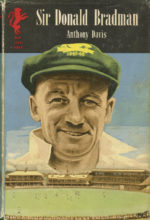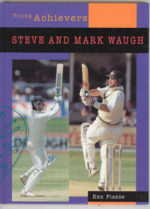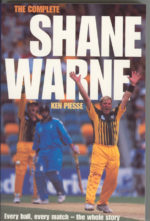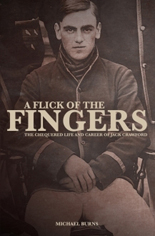Description
The chequered life and career of JN ‘Jack’ Crawford, much Australian interest, 2015 hardback
Additional information
| Published |
|---|
1 review for Burns, Michael – A Flick of the Fingers (JN Crawford’s story)
Add a review Cancel reply
You must be logged in to post a review.
Related products
-

Davis, Anthony – Sir Donald Bradman (biography)
Rated 0 out of 5$22.00 Add to cart -

Piesse, Ken – Steve and Mark Waugh (Young Achievers)
Rated 0 out of 5$44.00 Add to cart -

Whatmore, Dav – An Evening with Dav, Knox Tavern, Friday, 21st September, 2001 (souvenir)
Rated 0 out of 5$16.50 Add to cart -
Sale!

Piesse, Ken – The Complete Shane Warne
Rated 0 out of 5$16.50$5.50 Add to cart



Ken Piesse –
Review by Ken Piesse. Book available from cricketbooks.com.au
Son of an Anglican clergyman, sportsman for all seasons Jack Crawford was restless, inspired, bombastic, gifted and alluring.
England’s youngest Test cricketer, an allrounder of vitality and rare skill who would have been in his element in the modern-day Big Bash, JN Crawford was banned by his county club Surrey, emigrated to Australasia where he married a teenage Adelaide beauty, deserted her and continued on his goodtime cricketing jaunts.
Subject of the just released biography A Flick of the Fingers by filmmaker and writer Michael Burns, the buccaneering Crawford was a schoolboy prodigy who became the darling of Edwardian cricket and on emigrating to Australia was so highly rated that given a less conservative Board of Control he may have been selected for Australia.
Author David Lemmon says Crawford was the greatest possible waste – given he deserted English cricket before reaching his zenith – yet Harry Altham, a former Repton teammate, said Crawford ‘bestrode the game like a Colossus, remaining natural and friendly with us all and playing his cricket with infinite zest and always as a game.’
Fiercely independent and obstinate, Crawford’s height (he was at least 6 ft), head-turning good looks and spectacles ensured his place of importance in any roomful of socialites. He was also very aware of his net worth as a cricketer, coach and mentor. As Burns says he reveled in the fame, romance and excitement that a life in cricket afforded him.
Having fallen out with the autocratic Surrey committee over selection and leadership issues, Crawford was soon South Australia’s first official coach, capitalising on his liaison with Clem Hill during the 1907-08 MCC tour downunder.
In his first season of Sheffield Shield he helped SA to its first title in 16 years, scoring 73 not out and taking seven for 92 in the decider against powerful New South Wales in Sydney. He was part of a second Shield success, too.
Always wholehearted, his natural athleticism and fitness allowed him to bowl longer spells than most and Hill was just one to marvel at his ability to wrap his fingers enveloping almost the whole ball and making it seam both ways at pace even on the billiard like surfaces of Adelaide.
In 1913-14 he joined an unofficial Australian tour to New Zealand and scored 354 in one game against Fifteen of South Canterbury, striking 45 4s and 14 6s. Rejected the opportunity to continue coaching in Adelaide, he plied his trade on more lucrative terms in NZ, playing first-class cricket with two teams and leaving his wife during convoluted attempts to remain as far away as possible from the Great War and its frontline.
He penned an apology to Surrey – had his life ban lifted – and returning to England played some remarkable hands, including one hurricane 100 against expressman Jack Gregory and the Australian AIF side in 1919. Having struck Gregory on top of the member’s pavilion awning, he hooking him onto the nearby Kennington Oval tramlines on his way to an imperious 144 not out, the innings of his life. So glittering was his display that the Australian captain Bert Collins said: ‘It took your eyesight away.’
The cricket world seemed to forgive him of his philandering past and the wife he left became just as successful as he, in fashion circles. Ironically she ended up living fulltime in London before in 1924 becoming Lady Anita Smith, having married aviator Sir Keith Smith, the first with his brother Ross to fly from England to Australia.
Crawford’s story is unconventional and fascinating and well told. Unfortunately Burns bypasses the opportunity to seriously explore the theme of Crawford playing Test cricket for both England and Australia and leaves us dangling with just a paragraph: ‘Ultimately they (the Australian Board of Control) were not comfortable picking a player who had already played for another country.’ There is no further explanation or reference to many of the time who had represented two countries such as Billy Midwinter, Jack Ferris and Billy Murdoch.
A Flick of the Fingers is a hardback with a quality dustjacket but printed on poor quality paper, far from mistake-free and comes without an index or ending statistics.
Crawford’s motto was to play cricket and see the world. On his passing aged 76, he left the equivalent of 70,000 pounds to his second wife. It was indeed a good life – chequered, but good.